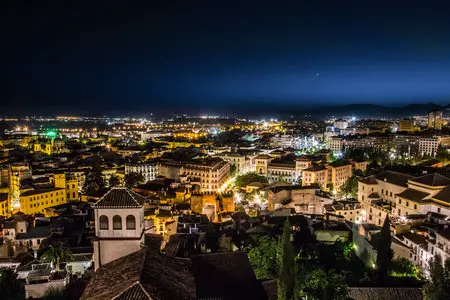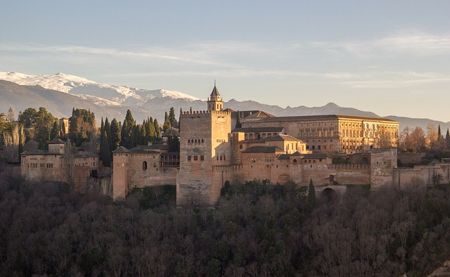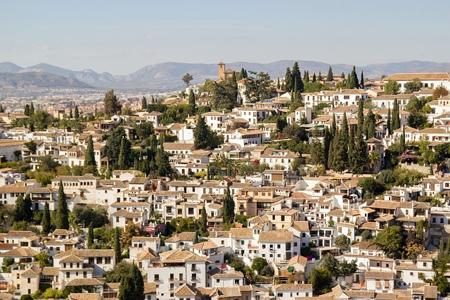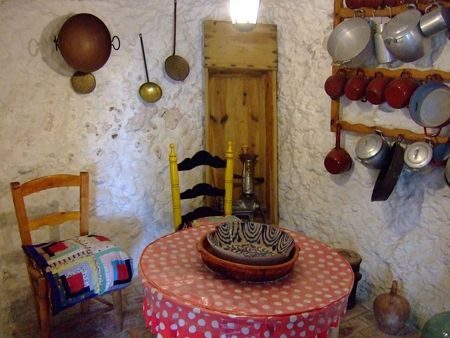The capital of the Andalusian region, Granada is one of the most historically rich European towns. Geographically, it’s at an advantage…Granada sits at the foot of Sierra Nevada and there is a confluence of 4 rivers here….Beiro, Darro, Monachil and Genil. Granada is at a fairly high elevation (approximately 2420 feet above sea level) and is yet just an hour’s scenic drive away from the lovely Mediterranean coast.
Like other important towns of Spain, Granada is full of lovely churches and museums. However, the Moorish Islamic influence on Granada differentiates it from the rest of the towns and cities…the architecture here is different and the Alhambra is the best example of it.

The Arabic Empire once stretched till northern Spain and Granada was one of the last places to be given up to the Christians. The centuries of rule by Caliphs, exotic Arabic sultans, and their royal dynasties have left an exquisitely regal touch in Granada and it can be exhilarating to see churches, mosques, Islamic mahals (palaces), and Tapas bars standing close to each other.
The ethnic cleansing that took here centuries ago has sucked out the Muslims and Jews rather cruelly but their legacy still lives on. Interestingly it was during this reinstatement of Christianity period that Christopher Columbus came to ask the reigning queen Isabel and Ferdinand for a loan to build a fleet of ships so that he could capture the Americas. The rest is a popular world history.
A Short Video
Attractions and Activities
The gigantic crimson fortress of Alhambra sits on a hill that overlooks Granada and is worth an entire day’s worth of time if you want to enjoy it properly. The Holy Koran reinstates the idea that heaven is a lovely garden with gushing water. This logically leads to the point that the Alhambra is an attempt by the Arabs to establish heaven on earth…once you visit it you will understand why.

More than 8000 people visit the monument every day and some lists include it amongst the ten wonders of the world. So many bars and cafes are inside the 140,000 sq. m ground space that you won’t feel the need to venture out. You will probably be spending most of your time in Generalife that’s a fantastic garden area attached to Alhambra…the Muslim emperors used to relax here amongst the gardens full of roses and ponds full of lilies. The landscaping in Islamic Nasrid style and the marvellous vistas of the city and the Sierra Nevada will charm you.
Tickets to the 4 attractions i.e. Alhambra palace, Generalife gardens, outdoor theatre (can see flamenco show for an added charge) and Carlos V are offered as a single package (booking online early is recommended)… the Palacio Carlos / Carlos V is a separate palace with lovely stonework and an art museum.
The Aynadamar (which means “fountain of tears”) was an Islamic enclosure beautifully filled with gushing fountains and orchards and right now it holds an artistic monastery of cloistered monks (known as Granada Charterhouse) that took 300 years to be completed. The architecture of the monastery reflects a variety of styles…its intricate arches are Plateresque designs while the courtyard has Doric Order columns and the tabernacle and Sancta Sanctorum has Baroque Spanish art. The glass doors of the church are decorated with silver, precious wood and mother of pearl constructs and the presbytery and main alter has gilded wood.
The Palace of the Marques de Salar was built on the Carrera del Darro Street and is a lovely architectural testament to the original Granada style of Renaissance transformation. The palace recently became a part of the Patio de Los Perfumes and its giant superficies and ample patio are great for enjoying city views while admiring the profusion of flowers around.
Another beautiful building in Granada is the Royal Chapel which houses the tombs of the Christian monarchs….Isabel and Fernando, Felipe and Juana etc. Incidentally, the chapel is built over the former grand terrace of the Mosque. The design of the Royal Chapel is a fusion of Spanish decorative, Goth and Renaissance styles and it houses a vast collection of priceless relics.
It has a great art gallery and was declared as a “historic-artistic monument” since 1884. A visit to the Royal chapel should naturally combine with a trip to the city centre and the Plaza bib Rambla and Plaza Neuva and Corral de Carbon.
The Albaicin is an interesting place to walk, paint and photograph… it’s an old Moorish quarter of Granada. It extends from San Nicolas to Darro river and Calle Elvira in Plaza Nueva. There are several cobblestoned streets and the homes have a typical Arabian structure with whitewashed high walls that cut off individual houses and enclosed gardens/ orchards. Many hundreds of years of neglect has not snatched away the charm of this place and there are fantastic views of the Alhambra at every turn.

Lots of Squares and Terrazas with places to talk and have Arabic food, while your shopping bags would now probably filled with lots of Islamic artefacts. Photographing from the famous viewpoint and a square on a hilltop known as Mirador de San Nicolas is sure to be one of the highlights of your trip. This plaza is located at one of the highest points of the Albaicín. The sunset view from here is said to be one of the best in the world. With Alhambra and Generalife are right ahead, Sierra Nevada behind, and the city right below, the view is simply awesome.
Don’t miss out on hearing the street music and watching the random performing art shows that are organised in this square every other day. You will be surprised to see churches in the typically Arabic setting…these are testaments of the Christian takeover of this land.
You probably know that Flamenco was originally an exclusive Gypsy song and dance art. Well, the gypsies had arrived in Spain about 600 years ago is Sacromonte …in the depths of its caves. The gypsy culture and the Moorish influence at that point created Flamenco. There are a number of reconstructed Flamenco gypsy caves here where the supposedly original version of the art is performed and it could be an interesting experience to watch. Rocio and Museo are two of the best places in this area where you can catch the Flamenco up close.
And even if the Flamenco doesn’t interest you much, the Sacromonte neighbourhood on the Valparaiso hills is an amazing place to explore… this was the haunt of the Romanis who settled down after conquering this part of the world. The whitewashed artificial caves used as homes and the strumming Spanish guitar melodies all around create a magical atmosphere. The abbey of Sacromonte and the Sacromonte College are two important monuments that you shouldn’t miss visiting.

Another interesting neighbourhood here is Realejo the old Jewish settlement…though it’s highly populated and filled with great Tapas bars now. Look out for the Campo del Principe (which means “field of the Prince”) which is a large plaza that was originally created by the Catholic monarchs to hold wedding functions. During the summers, this plaza becomes a great venue for Granada’s nightlife with many open-air bars and tapas bars springing up.
At a short distance from Campo del Principe and up the slope is the beautiful Church of San Cecilio (the patron saint of Granada). This is a centuries-old Catholic church and features a wonderful facade with intricate work and gilded religious statues. The Palace la Casa de Los Tiros and Los Condes Palace along with Santo Domingo church are other attractions. This area is near Alhambra so take a self-guided walking tour from Alhambra to Realejo to San Matias Street which is again filled with lovely monuments like Gran Capitan House, St Mathias Church and Mercedarias convent.
An interesting experience in Granada is to have an Arab Bath…and there’s no better place to do it than the Aljibe De San Miguel with its 7 different pools (each has different temperatures). Lovely music is played and there are relaxing oil platters available for a long massage. This place is in a deceptively modern neighbourhood called Calle San Miguel Alta (this is near Calle Puentezuelas). In ancient times baths were a beauty and relaxation ritual and people would meet and converse while spending a relaxed hour in the waters.
An interesting way to explore Granada is by taking the Segway tour…this is a computer-controlled 2 wheel transport device that’s kind of self-regulated and goes on a thorough tour of Granada.
Should you wish to go on day trips then walking on the Caminito Del Rey (138 km away) ….a narrow walkway on the rocky side of Chorro Gorge in Malaga can be an adventurous option. A less strenuous option is exploring the Ronda town (bullfighting hub and historical town) that’s about 177 km away.
Venture further out and there is Cordoba with its Palacio de Viana, Alcazar de Rees and Mosques (200 km away). Alternatively, go to the gorgeous ski resorts and the national park in the Sierra Nevada…especially delightful if you have arrived in summer. The ski resort in Prodollano offers a fantastic night skiing experience…whizz off under the moonlight. The areas under the Alpujarra villages have great yoga and organic living retreats…good places to go to if you want to de-stress
Food and Drinks
Granada like all Spanish cities is passionate about its food. The food here has decidedly Arab influences though in general it can be categorised as Andalusian cuisine. You will find an abundance of Shwarma and kebabs here apart from typical Spanish food like paella, cured ham, tortillas, tomato and olive oil-rubbed bread and hearty meat and cheese dishes.
If you are visiting in the summers you will be having cold tomato-based soups like Gazpacho and Samorejo with Ensalada de la Casa (mixed green salads). Other common dishes are Revuelto de esparragos… scrambled eggs with garlic asparagus mushrooms etc and cold cuts of meat.
The Jamón de Trevélez or ham cured to divinity is a must-try item in Granada. The Mariscal Delicatessen at Carrera de la Virgen is one of the best places to have a plateful of Jamon with Spanish wine and then carry back a bagful for later meals. There are numerous cured meat shops all over Granada like the Paseo del Salon shop, Contreras Selectos which stock hams and deli products…these places are great to pick up food which you can have later at your hotel/ apartment.
A popular Granada dessert (or mid-day snack) is Pionono …a tiny melting sweet which originated in Santa Fey. You will also find Crème Catalana, Natillas (tastes like custard), cheesecake and Arroz Leche (tastes like rice pudding).
When in Granada don’t forget to sip on (and shop for) delicious Andulasian wines. D.O Granada (wine produced in the vineyards of Granada), Montilla Moriles (Codorba provincial wine), D.O Malaga (a sweet fortified wine), Condado de Huelva (western Andalusian province of Huelva) are some of the bottles you should order. Also, sip on sherry (it’s not always sweet as you will pleasantly discover) from the Jerez region in the province of Cadiz.
Now that you know what to eat and drink, quickly choose places near your favourite attractions to have them. Inside the Alhambra complex, there is La Mimbre with its Habas con Jamon and Oxtail stews. Steps away from the fragrant Generalife gardens is the Jardines Alberto that has a nice menu del dia locals (2 courses, drinks, dessert and bread for a cheap price). For an intimate and quiet meal head to the restaurant Hotel Guadalupe with its moderately pricey pure Andalusian menu. Las Tomasa’s with its pretty terrace and organic food is near the Alhambra too.
When touring Sacromonte slip inside the family-run Casa Juanilo with its traditional Andalusian food (try the pisto). Jardines de Zoraya offers Flamenco along with food so that’s a definite advantage. In Calle Almicereros there is the Bodegas Sataneda…a simple joint serving great tortillas and tapas.
If you are visiting the Albayzin quarters then the elegant Mirador de Morayma serves lovely tortilla variations too especially the tortilla de Sacromonte. It offers the experience of dining inside a Carmen (local Granadian house) and it has a beautiful garden where you can choose to have your meals. Also in Albayzin is Loft Café with its amazing 8 different types of brunch offerings from 11 a.m. to 2 p.m.
And if you have just arrived in the city centre of Granada then head off to Calle Colcha’s Restaurante Carmela that has customised tortillas and great Spanish fusion food. Restaurant Carmela serves some excellent brunch too and so does its sister outlet La Cuchara de Carmela.
Nightlife
Granada is different from many European cities…it’s a lot quieter here around holidays. This is because the students of this town (more than 8,000 of them as of 2018) return home in summer and the locals hang out at the beaches nearby. There are two basic hot zones for nightlife though nowadays the entire town lives it up at night.
The Pedro Alarcon zone has young nightlife…you will find lots of students and teens here. Calle Elvira and Plaza Nueva see mixed crowds and if you are over 25 then visiting these zones makes sense. A smart way to get a synopsis of what’s happening in different bars and nightclubs is to check out their posters. A big collection of such posters are there behind Gobierno Civil on Gran Via i.e. the Pata Palo.
Eshavira in Calle Alvira has great jazz performances and El Son has a lively disco. Miniclub and Pata Palo are 2 other good places to go to. On the other hand, Gran Via de Colon has Entresuelo with its reggae music and dancing scene while Plantabaja is a good platform for Spanish underground music stars. Go westwards and you will reach the Booga Club with its nice live music and Afrodisia with its sixties vibe.
Head off to Bar Poe (in Calle veronica de la Magdalena) which serves innovative free tapas with drinks. Bar Avila (in Calle Veronica de la Virgen) serves very late night meals of Salmorejo and Jamon asado with barrels of wine and it’s affordable. The Spanish wine selection in La Tana in Placeta Del Agua is great.
And if Spanish wine doesn’t interest you and German beer does then head off for a late-night of drinking to Wursmet (in Calle Martinez Rosa) that looks like it has stepped out of Berlin. El Tabernaculo celebrates Semana Santa each day with delish Sangria and free tapas…this is one of the best hangouts in the pub rich Calle Navas area. In the Realejo neighbourhood, there is the relaxed Bar Faquila…perfect for people who don’t like typical boisterous pubs.
Shopping
In Granada, there are certain areas that sell unique artefacts specific to this region. In Albayzin you will find clothes, furniture, bags and mirrors with an Arabian touch…this is an affordable place to shop. Granada is also known for lovely pottery (called Fajalauza) that dates back to the 16th century. The Fajalzauza Ceramica on Carretera de Murcia sells the best of pottery.
In the Alcaiceria area near the lovely Granada Cathedral is the Alcaiceria Market (an old silk market) that dates back to the days of the Moor princes. Shop for anklets, Arabic scripts, mirrored boxes and souvenirs here. Cuesta Gomerez Street has amazing architecture and a great stock of trinkets, postcards, marquetry boxes and ceramics.
For shopping for fruits, fresh produce, wine and cheese the Mercado San Augustin market (till 2.00 p., Mon to Sat) is a great venue. The Plaza Larga in the Albayzin area has lots of stalls selling fresh fruit and vegetables along with lovely flowers. Bib Rambla has lots of small shops and cafes and a lovely flower market…this is a good place to click pictures and people watch too.
There are lots of weekly and monthly speciality markets in Granada like the La Marcha Verde that happens on Sunday mornings near the Granada bus stand…you will get clothes, curios and electronic stuff here at cheap prices. The Puerta Real and Paseo de Los Tristes areas keep organising different fairs for antiques, artwork, coins and stamps, fresh fruit and books etc…if you are lucky you will be in town for one!!
And if you are all set to splurge then go to El Cortes Ingles with its nice collection of designer apparel and accessories or the Puerta Real area streets i.e. Reyes Catolicos, Calle Mesones, San Anton etc for a healthy dose of Zara, Espirit, Mango etc though Granada is not really the ideal destination for brand shopping.
The Moorish jewel of South Spain is more interested in filling up your hearts than your bags.
How to reach
By Road: Road access is via the A-44 highway and this route links Granada in the north with Jaen, Bailen and Madrid and in the south with Motril and the coast. The A-2 runs westwards to Cordoba, Badajoz, Malaga and Seville, and eastwards to Murcia and Almeria…these are your routes if you come via bus or a hired car.
By Air: Federico Garcia Lorca Airport is 15 km from Granada city centre and fights ply from Madrid (4 hours), Barcelona (1 hr. 27 min), Palma, Bilboa, Tenerife, Las Palmas, Melilla, and also from Paris, London, Manchester and Milan. You can also land at Costa Del Sol International airport in Malaga, 130 km from Granada. To travel from Asian cities you need to connect via Madrid or Barcelona.
By Train: There are trains to Avenida de Andalucía station from Barcelona and Madrid, and few other direct national routes though connections are not that frequent. Apart from this, you can also travel from Madrid to Malaga by AVE high-speed train and then continue to Granada. Regional rail services also ply from Granada to Almeria, Seville, Algeciras and Linares.
Getting Around
The red-painted minibuses will take you uphill to Alhambra and Generalife and some areas of Albayzin and Sacromonte. These usually run from 6.45 am to 11 pm on all days….all around the city. Regional Buses originate from around the Carretera de Jaen (major bus station) and go to Cordoba, Seville, Malaga and Ski resorts of Sierra Nevada amongst other places.
The Renfe Spain Pass allows non-residents and tourists to travel around Spain by train. This pass can be used in all AVE long-distance and mid-distance high-speed trains. The pass is valid for one month and comes in two formats (business/club and tourist). Can be purchased up to six months in advance and is available for 4, 6, 8 or 10 journeys.
Consider taking a tourist train for Granada city tour which takes two routes, one via the La Alhambra and another through the city centre…this is a good option.
You can also enter Granada By Sea via Port of Motril that is another entry point which is located just 70 km away.
The easiest way to roam around Granada is by walking, hiring scooters, bicycles and segways…ideally opt for a bus only when you have to climb on hills and are not comfortable doing it. The segway tours begin from Plaza Nueva and last for approximately 90 minutes…you will have a choice of 3/ 4 routes and your weight needs to be within a limit of BMI (body mass index range) in order to participate.
You will also see open top hop on hop off sightseeing buses in addition to taxis that go between different places around the city.
Read: How to easily get around Granada using public transports.
When to Go
Granada has and is basically an all-season destination. If you are from cooler climes then October/ November will appeal to you when the air in Granada is cool and balmy and the crowds are thin. August is avoidable…everyone goes on vacation and many shops and restaurants are closed.
In summers most locals go to the seaside so you will find shorter queues though the weather may appear uncomfortably warm especially considering the fact that you will be walking a lot.
Late winters can be amazing if you aren’t scared of the cold…you can ski in the ski resorts in the morning and head back to the beaches in the afternoon. March April is when the roses bloom and nature is at her best and September sees a lot of music and art festivals. Every month has something special to offer in Granada.
Read: Important weather conditions in Spain
 A travel addict. Still celebrating the day when he quit his high-profile corporate job to pursue his passion for travel writing.
A travel addict. Still celebrating the day when he quit his high-profile corporate job to pursue his passion for travel writing.